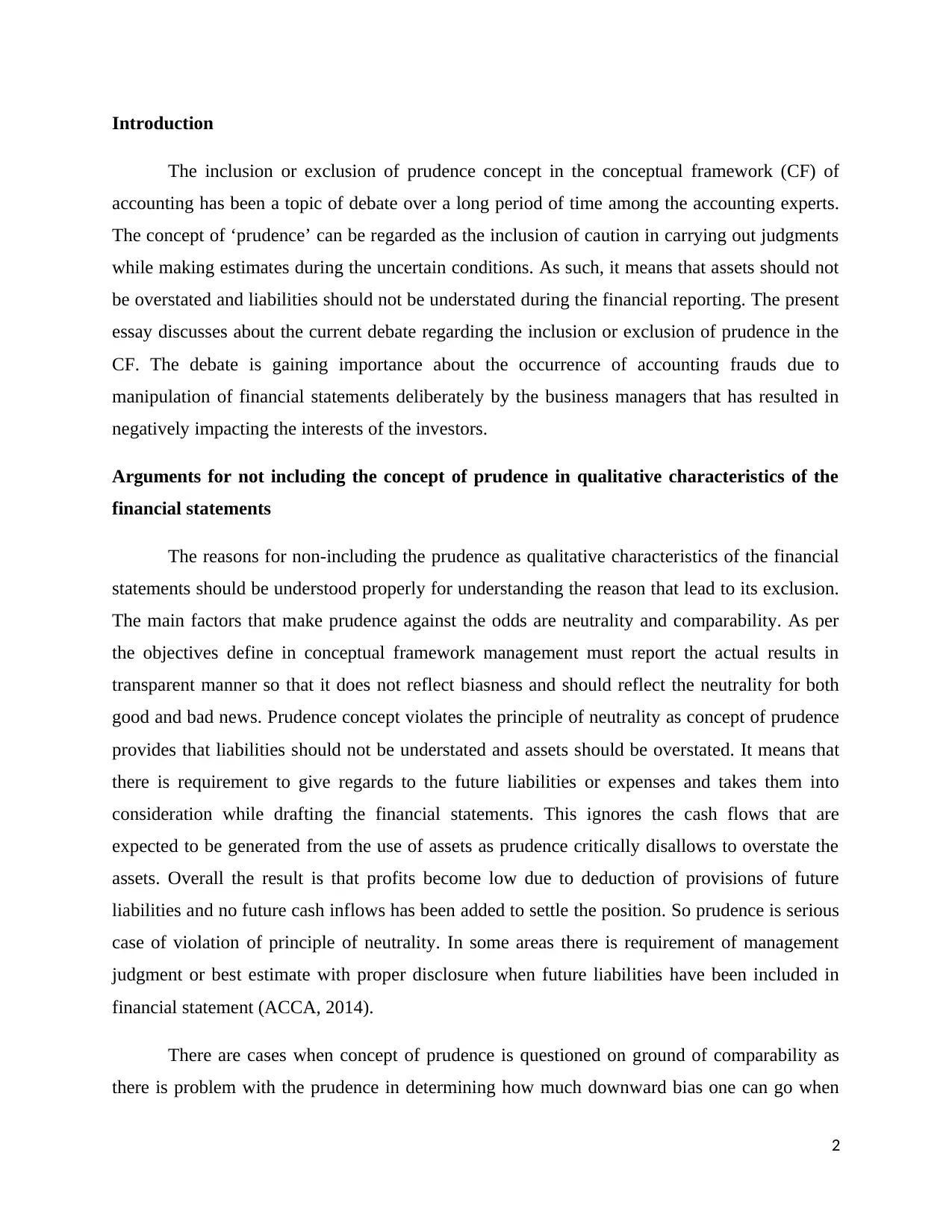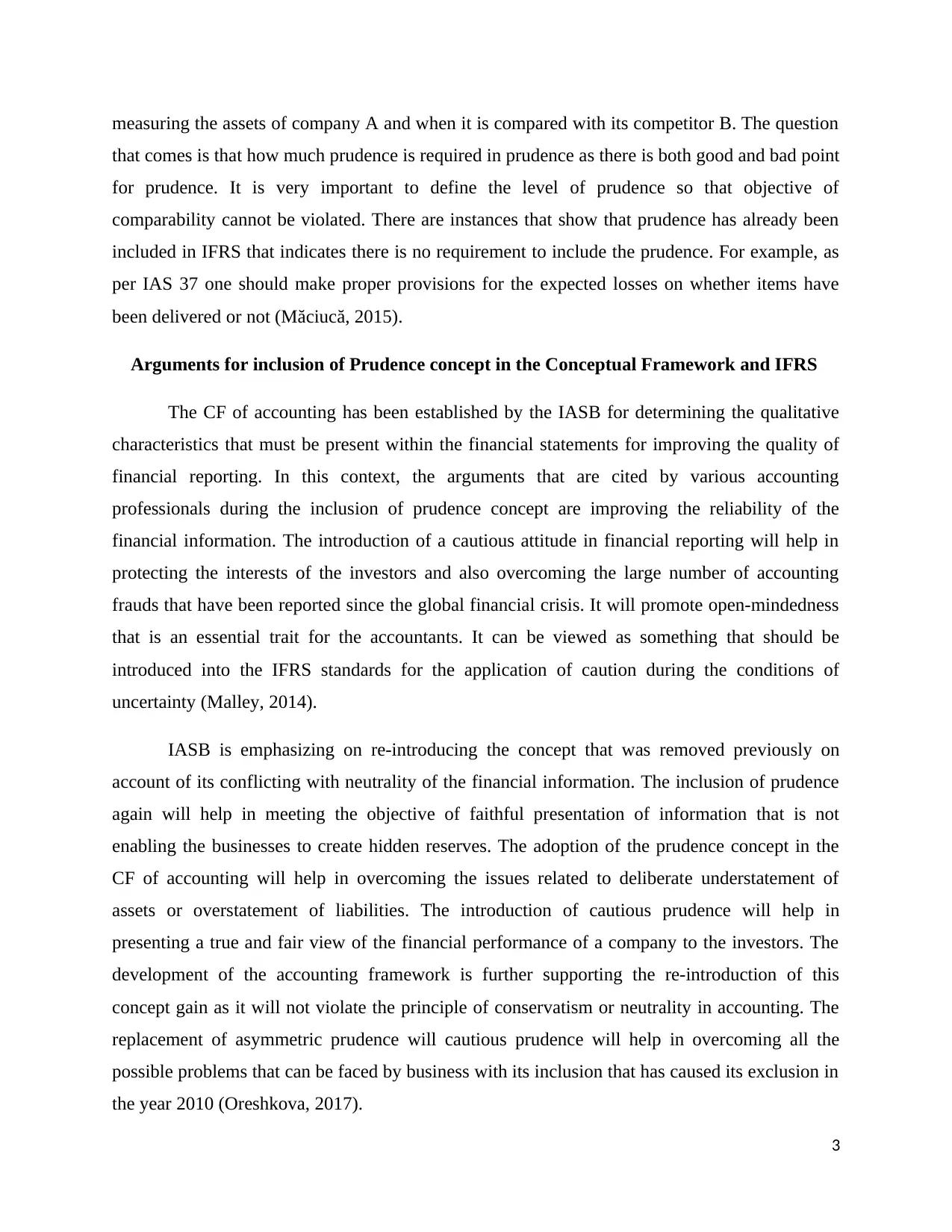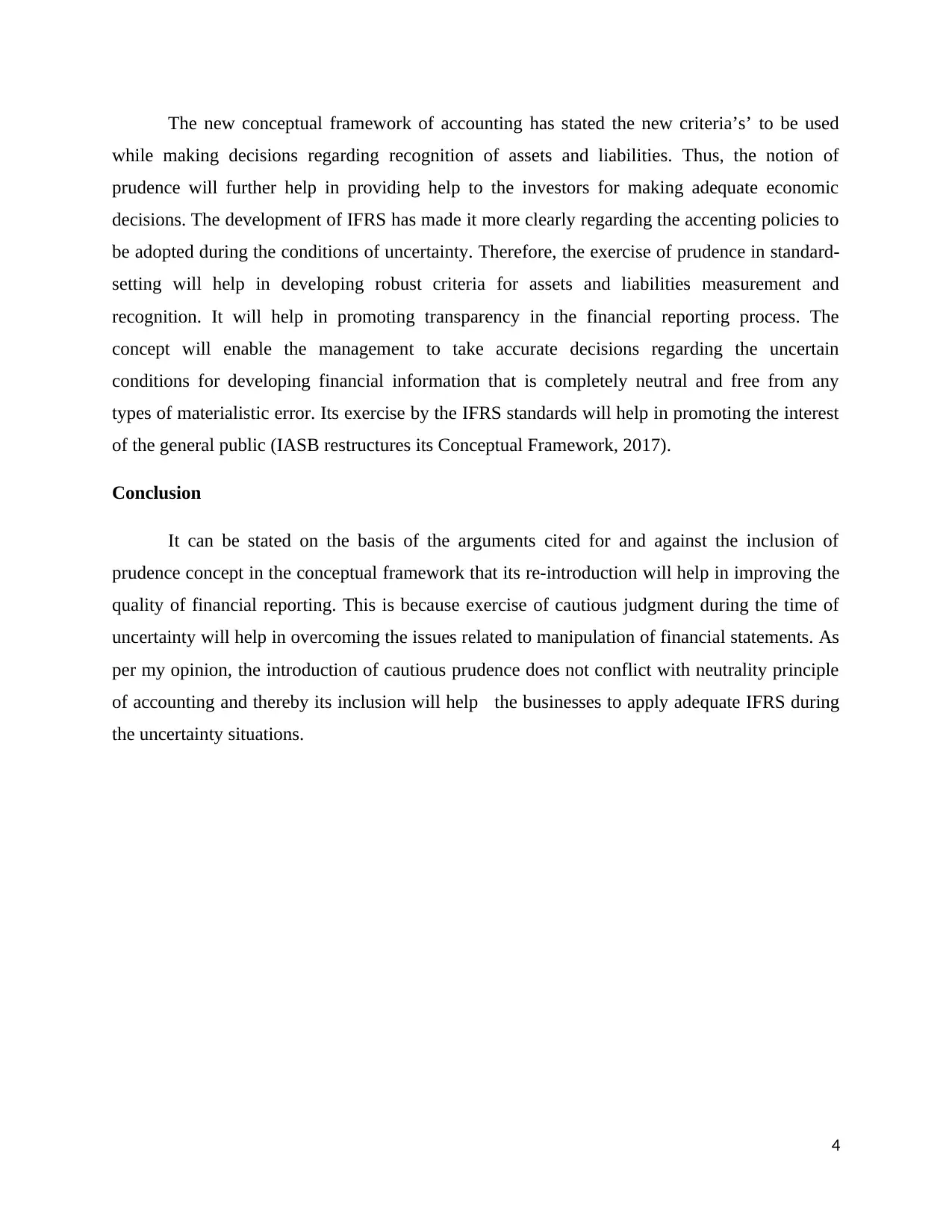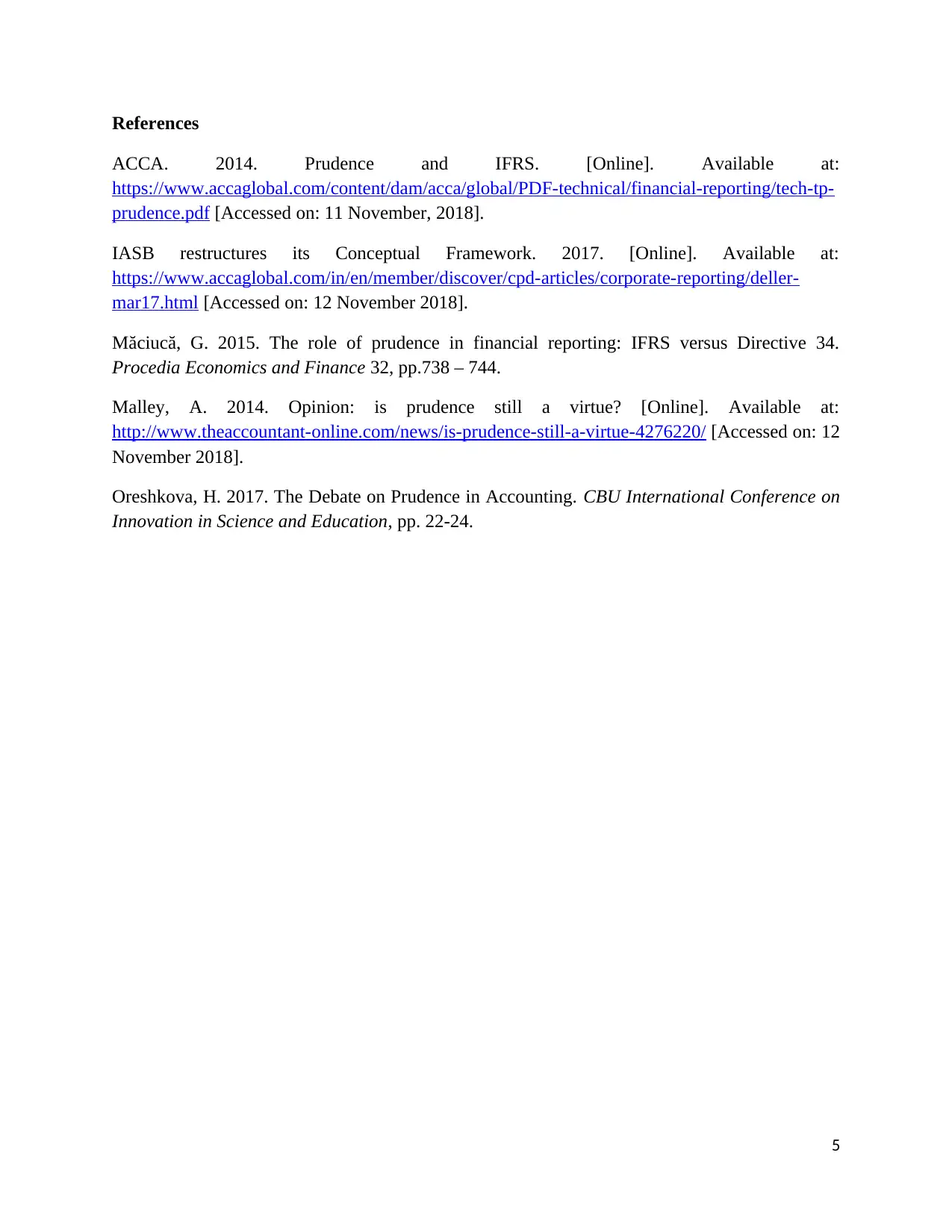Analyzing Prudence: Its Role in Conceptual Framework of Accounting
VerifiedAdded on 2023/05/29
|5
|1247
|192
Essay
AI Summary
This essay delves into the ongoing debate surrounding the inclusion or exclusion of the 'prudence' concept within the conceptual framework (CF) of accounting. Prudence, defined as exercising caution when making estimates under uncertainty, suggests that assets should not be overstated, and liabilities should not be understated. The essay presents arguments both for and against its inclusion, highlighting concerns about neutrality and comparability versus the need for reliable financial information and the prevention of accounting fraud. It explores how the re-introduction of cautious prudence could improve financial reporting quality by promoting transparency and enabling better decision-making in uncertain conditions, while also considering potential conflicts with the principle of neutrality. The conclusion suggests that re-introducing cautious prudence can enhance the application of IFRS in uncertain situations, ultimately improving the overall quality of financial reporting. Desklib provides access to this essay, offering students valuable study tools.

Accounting
1
1
Paraphrase This Document
Need a fresh take? Get an instant paraphrase of this document with our AI Paraphraser

Introduction
The inclusion or exclusion of prudence concept in the conceptual framework (CF) of
accounting has been a topic of debate over a long period of time among the accounting experts.
The concept of ‘prudence’ can be regarded as the inclusion of caution in carrying out judgments
while making estimates during the uncertain conditions. As such, it means that assets should not
be overstated and liabilities should not be understated during the financial reporting. The present
essay discusses about the current debate regarding the inclusion or exclusion of prudence in the
CF. The debate is gaining importance about the occurrence of accounting frauds due to
manipulation of financial statements deliberately by the business managers that has resulted in
negatively impacting the interests of the investors.
Arguments for not including the concept of prudence in qualitative characteristics of the
financial statements
The reasons for non-including the prudence as qualitative characteristics of the financial
statements should be understood properly for understanding the reason that lead to its exclusion.
The main factors that make prudence against the odds are neutrality and comparability. As per
the objectives define in conceptual framework management must report the actual results in
transparent manner so that it does not reflect biasness and should reflect the neutrality for both
good and bad news. Prudence concept violates the principle of neutrality as concept of prudence
provides that liabilities should not be understated and assets should be overstated. It means that
there is requirement to give regards to the future liabilities or expenses and takes them into
consideration while drafting the financial statements. This ignores the cash flows that are
expected to be generated from the use of assets as prudence critically disallows to overstate the
assets. Overall the result is that profits become low due to deduction of provisions of future
liabilities and no future cash inflows has been added to settle the position. So prudence is serious
case of violation of principle of neutrality. In some areas there is requirement of management
judgment or best estimate with proper disclosure when future liabilities have been included in
financial statement (ACCA, 2014).
There are cases when concept of prudence is questioned on ground of comparability as
there is problem with the prudence in determining how much downward bias one can go when
2
The inclusion or exclusion of prudence concept in the conceptual framework (CF) of
accounting has been a topic of debate over a long period of time among the accounting experts.
The concept of ‘prudence’ can be regarded as the inclusion of caution in carrying out judgments
while making estimates during the uncertain conditions. As such, it means that assets should not
be overstated and liabilities should not be understated during the financial reporting. The present
essay discusses about the current debate regarding the inclusion or exclusion of prudence in the
CF. The debate is gaining importance about the occurrence of accounting frauds due to
manipulation of financial statements deliberately by the business managers that has resulted in
negatively impacting the interests of the investors.
Arguments for not including the concept of prudence in qualitative characteristics of the
financial statements
The reasons for non-including the prudence as qualitative characteristics of the financial
statements should be understood properly for understanding the reason that lead to its exclusion.
The main factors that make prudence against the odds are neutrality and comparability. As per
the objectives define in conceptual framework management must report the actual results in
transparent manner so that it does not reflect biasness and should reflect the neutrality for both
good and bad news. Prudence concept violates the principle of neutrality as concept of prudence
provides that liabilities should not be understated and assets should be overstated. It means that
there is requirement to give regards to the future liabilities or expenses and takes them into
consideration while drafting the financial statements. This ignores the cash flows that are
expected to be generated from the use of assets as prudence critically disallows to overstate the
assets. Overall the result is that profits become low due to deduction of provisions of future
liabilities and no future cash inflows has been added to settle the position. So prudence is serious
case of violation of principle of neutrality. In some areas there is requirement of management
judgment or best estimate with proper disclosure when future liabilities have been included in
financial statement (ACCA, 2014).
There are cases when concept of prudence is questioned on ground of comparability as
there is problem with the prudence in determining how much downward bias one can go when
2

measuring the assets of company A and when it is compared with its competitor B. The question
that comes is that how much prudence is required in prudence as there is both good and bad point
for prudence. It is very important to define the level of prudence so that objective of
comparability cannot be violated. There are instances that show that prudence has already been
included in IFRS that indicates there is no requirement to include the prudence. For example, as
per IAS 37 one should make proper provisions for the expected losses on whether items have
been delivered or not (Măciucă, 2015).
Arguments for inclusion of Prudence concept in the Conceptual Framework and IFRS
The CF of accounting has been established by the IASB for determining the qualitative
characteristics that must be present within the financial statements for improving the quality of
financial reporting. In this context, the arguments that are cited by various accounting
professionals during the inclusion of prudence concept are improving the reliability of the
financial information. The introduction of a cautious attitude in financial reporting will help in
protecting the interests of the investors and also overcoming the large number of accounting
frauds that have been reported since the global financial crisis. It will promote open-mindedness
that is an essential trait for the accountants. It can be viewed as something that should be
introduced into the IFRS standards for the application of caution during the conditions of
uncertainty (Malley, 2014).
IASB is emphasizing on re-introducing the concept that was removed previously on
account of its conflicting with neutrality of the financial information. The inclusion of prudence
again will help in meeting the objective of faithful presentation of information that is not
enabling the businesses to create hidden reserves. The adoption of the prudence concept in the
CF of accounting will help in overcoming the issues related to deliberate understatement of
assets or overstatement of liabilities. The introduction of cautious prudence will help in
presenting a true and fair view of the financial performance of a company to the investors. The
development of the accounting framework is further supporting the re-introduction of this
concept gain as it will not violate the principle of conservatism or neutrality in accounting. The
replacement of asymmetric prudence will cautious prudence will help in overcoming all the
possible problems that can be faced by business with its inclusion that has caused its exclusion in
the year 2010 (Oreshkova, 2017).
3
that comes is that how much prudence is required in prudence as there is both good and bad point
for prudence. It is very important to define the level of prudence so that objective of
comparability cannot be violated. There are instances that show that prudence has already been
included in IFRS that indicates there is no requirement to include the prudence. For example, as
per IAS 37 one should make proper provisions for the expected losses on whether items have
been delivered or not (Măciucă, 2015).
Arguments for inclusion of Prudence concept in the Conceptual Framework and IFRS
The CF of accounting has been established by the IASB for determining the qualitative
characteristics that must be present within the financial statements for improving the quality of
financial reporting. In this context, the arguments that are cited by various accounting
professionals during the inclusion of prudence concept are improving the reliability of the
financial information. The introduction of a cautious attitude in financial reporting will help in
protecting the interests of the investors and also overcoming the large number of accounting
frauds that have been reported since the global financial crisis. It will promote open-mindedness
that is an essential trait for the accountants. It can be viewed as something that should be
introduced into the IFRS standards for the application of caution during the conditions of
uncertainty (Malley, 2014).
IASB is emphasizing on re-introducing the concept that was removed previously on
account of its conflicting with neutrality of the financial information. The inclusion of prudence
again will help in meeting the objective of faithful presentation of information that is not
enabling the businesses to create hidden reserves. The adoption of the prudence concept in the
CF of accounting will help in overcoming the issues related to deliberate understatement of
assets or overstatement of liabilities. The introduction of cautious prudence will help in
presenting a true and fair view of the financial performance of a company to the investors. The
development of the accounting framework is further supporting the re-introduction of this
concept gain as it will not violate the principle of conservatism or neutrality in accounting. The
replacement of asymmetric prudence will cautious prudence will help in overcoming all the
possible problems that can be faced by business with its inclusion that has caused its exclusion in
the year 2010 (Oreshkova, 2017).
3
⊘ This is a preview!⊘
Do you want full access?
Subscribe today to unlock all pages.

Trusted by 1+ million students worldwide

The new conceptual framework of accounting has stated the new criteria’s’ to be used
while making decisions regarding recognition of assets and liabilities. Thus, the notion of
prudence will further help in providing help to the investors for making adequate economic
decisions. The development of IFRS has made it more clearly regarding the accenting policies to
be adopted during the conditions of uncertainty. Therefore, the exercise of prudence in standard-
setting will help in developing robust criteria for assets and liabilities measurement and
recognition. It will help in promoting transparency in the financial reporting process. The
concept will enable the management to take accurate decisions regarding the uncertain
conditions for developing financial information that is completely neutral and free from any
types of materialistic error. Its exercise by the IFRS standards will help in promoting the interest
of the general public (IASB restructures its Conceptual Framework, 2017).
Conclusion
It can be stated on the basis of the arguments cited for and against the inclusion of
prudence concept in the conceptual framework that its re-introduction will help in improving the
quality of financial reporting. This is because exercise of cautious judgment during the time of
uncertainty will help in overcoming the issues related to manipulation of financial statements. As
per my opinion, the introduction of cautious prudence does not conflict with neutrality principle
of accounting and thereby its inclusion will help the businesses to apply adequate IFRS during
the uncertainty situations.
4
while making decisions regarding recognition of assets and liabilities. Thus, the notion of
prudence will further help in providing help to the investors for making adequate economic
decisions. The development of IFRS has made it more clearly regarding the accenting policies to
be adopted during the conditions of uncertainty. Therefore, the exercise of prudence in standard-
setting will help in developing robust criteria for assets and liabilities measurement and
recognition. It will help in promoting transparency in the financial reporting process. The
concept will enable the management to take accurate decisions regarding the uncertain
conditions for developing financial information that is completely neutral and free from any
types of materialistic error. Its exercise by the IFRS standards will help in promoting the interest
of the general public (IASB restructures its Conceptual Framework, 2017).
Conclusion
It can be stated on the basis of the arguments cited for and against the inclusion of
prudence concept in the conceptual framework that its re-introduction will help in improving the
quality of financial reporting. This is because exercise of cautious judgment during the time of
uncertainty will help in overcoming the issues related to manipulation of financial statements. As
per my opinion, the introduction of cautious prudence does not conflict with neutrality principle
of accounting and thereby its inclusion will help the businesses to apply adequate IFRS during
the uncertainty situations.
4
Paraphrase This Document
Need a fresh take? Get an instant paraphrase of this document with our AI Paraphraser

References
ACCA. 2014. Prudence and IFRS. [Online]. Available at:
https://www.accaglobal.com/content/dam/acca/global/PDF-technical/financial-reporting/tech-tp-
prudence.pdf [Accessed on: 11 November, 2018].
IASB restructures its Conceptual Framework. 2017. [Online]. Available at:
https://www.accaglobal.com/in/en/member/discover/cpd-articles/corporate-reporting/deller-
mar17.html [Accessed on: 12 November 2018].
Măciucă, G. 2015. The role of prudence in financial reporting: IFRS versus Directive 34.
Procedia Economics and Finance 32, pp.738 – 744.
Malley, A. 2014. Opinion: is prudence still a virtue? [Online]. Available at:
http://www.theaccountant-online.com/news/is-prudence-still-a-virtue-4276220/ [Accessed on: 12
November 2018].
Oreshkova, H. 2017. The Debate on Prudence in Accounting. CBU International Conference on
Innovation in Science and Education, pp. 22-24.
5
ACCA. 2014. Prudence and IFRS. [Online]. Available at:
https://www.accaglobal.com/content/dam/acca/global/PDF-technical/financial-reporting/tech-tp-
prudence.pdf [Accessed on: 11 November, 2018].
IASB restructures its Conceptual Framework. 2017. [Online]. Available at:
https://www.accaglobal.com/in/en/member/discover/cpd-articles/corporate-reporting/deller-
mar17.html [Accessed on: 12 November 2018].
Măciucă, G. 2015. The role of prudence in financial reporting: IFRS versus Directive 34.
Procedia Economics and Finance 32, pp.738 – 744.
Malley, A. 2014. Opinion: is prudence still a virtue? [Online]. Available at:
http://www.theaccountant-online.com/news/is-prudence-still-a-virtue-4276220/ [Accessed on: 12
November 2018].
Oreshkova, H. 2017. The Debate on Prudence in Accounting. CBU International Conference on
Innovation in Science and Education, pp. 22-24.
5
1 out of 5
Related Documents
Your All-in-One AI-Powered Toolkit for Academic Success.
+13062052269
info@desklib.com
Available 24*7 on WhatsApp / Email
![[object Object]](/_next/static/media/star-bottom.7253800d.svg)
Unlock your academic potential
Copyright © 2020–2025 A2Z Services. All Rights Reserved. Developed and managed by ZUCOL.





